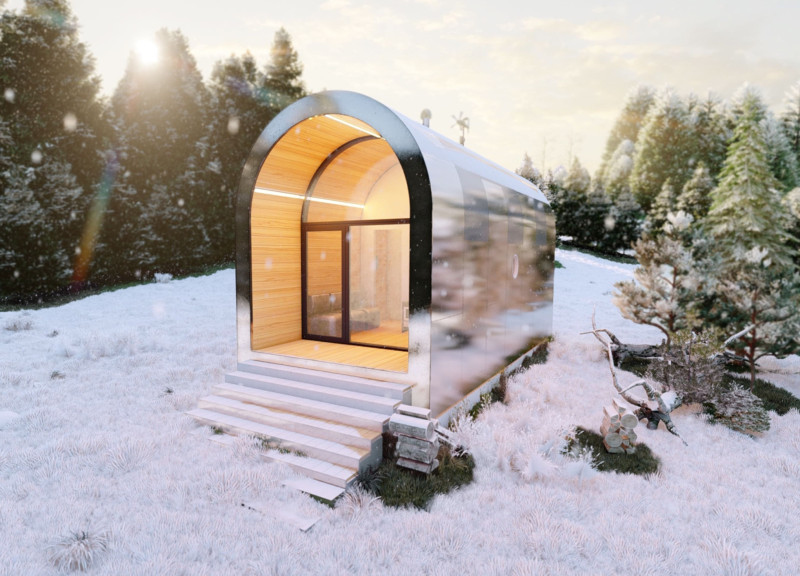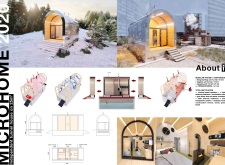5 key facts about this project
At its core, the Microhome is designed for urban dwellers seeking independence and a minimalist lifestyle. The project challenges conventional housing norms by redefining how space can be utilized effectively, without compromising comfort or efficiency. The architecture invites occupants to reconsider the relationship between their living environment and the natural world, promoting a lifestyle that is both sustainable and connected to its surroundings.
One of the most distinctive aspects of this project is its innovative tunnel-like structure. This rounded design not only contributes to the aesthetic appeal of the microhome but also enhances its structural integrity and energy efficiency. By featuring a curved roof profile, the home effectively channels rainwater and prevents snow accumulation, making it versatile across various climatic conditions. This architectural choice reflects a profound understanding of environmental adaptability, ensuring that the microhome can thrive in different geographical locations, from urban cities to rural landscapes.
The exterior of the Microhome is characterized by a combination of durable metal and natural wood materials. This marriage of materials establishes a visual and tactile contrast that emphasizes the project’s commitment to both aesthetic appeal and longevity. Large transparent glass panels form a spacious entryway, allowing natural light to flood the interior, thereby extending the spatial perception and enhancing overall wellness. This careful interplay of materials highlights a dedication to quality while facilitating a seamless transition between indoor and outdoor environments.
Internally, the microhome is structured into well-defined zones that maximize utility within the limited space. The primary living area serves dual purposes as both a lounge and workspace, encouraging flexibility and productivity. The intelligent incorporation of multifunctional furniture helps maintain an organized and uncluttered environment, which is essential in achieving a minimalist lifestyle. Additionally, a compact hygiene unit carefully balances functionality and privacy, while the sleeping area is thoughtfully designed to include innovative storage solutions, keeping the ground area free for movement.
The Microhome also emphasizes environmental responsibility through the integration of self-sufficient systems. With a keen focus on minimizing waste, the design includes a heat-retaining fireplace and an incineration toilet, which significantly reduces water consumption. Moreover, the project incorporates rainwater and graywater recycling systems, further promoting sustainable living practices. The installation of solar panels supports energy independence, reflecting a noteworthy commitment to harnessing renewable resources.
Unique design approaches shine through not only in the architectural layout but also in the philosophy behind the Microhome. By prioritizing adaptability, the design offers users the ability to customize their space according to personal needs or changing circumstances, presenting a solution to the evolving nature of modern living. This flexibility encourages occupants to view their home as a dynamic space rather than a static one, fostering a deeper connection to both the structure and the surrounding environment.
In summary, the Microhome serves as a compelling exploration of contemporary architecture that embraces sustainability, adaptability, and efficient use of space. Its unique design encourages occupants to engage with their living space in meaningful ways, promoting a lifestyle that values quality over quantity. For a more comprehensive understanding of this project, including its architectural plans, sections, and design ideas, readers are encouraged to explore the project presentation in detail. This exploration will provide valuable insights into the innovative strategies employed in crafting an effective micro-living solution.























